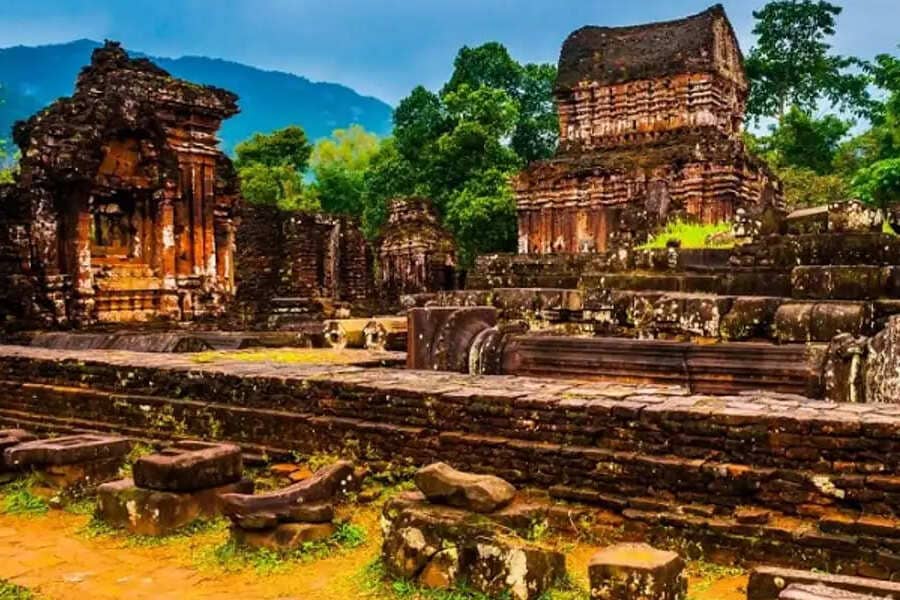My Son Sanctuary, situated in central Vietnam, consists of Hindu temple ruins dating from the 4th to 13th centuries CE. These red brick towers, decorated with intricate carvings, epitomize the architectural and cultural accomplishments of the ancient Champa civilization. Recognized as a UNESCO World Heritage Site, My Son provides insight into Vietnam’s rich history and the spiritual traditions of its former residents.
The geographical location and history of My Son Sanctuary
My Son Sanctuary, located in central Vietnam amidst the lush Quang Nam Province, is a remarkable collection of Hindu temple ruins dating back to the Champa Kingdom, spanning from the 4th to the 13th centuries CE. Situated approximately 69 kilometers southwest of Da Nang and near Tra Kieu town, this UNESCO World Heritage Site holds deep cultural and historical significance. Dedicated primarily to the worship of Shiva, a principal deity in Hinduism, the sanctuary’s red brick temples feature intricate carvings and bas-reliefs that showcase the architectural brilliance of the Champa civilization. These structures, blending Indigenous Cham and Indian architectural styles, stand as enduring symbols of the region’s rich cultural heritage and spiritual traditions.
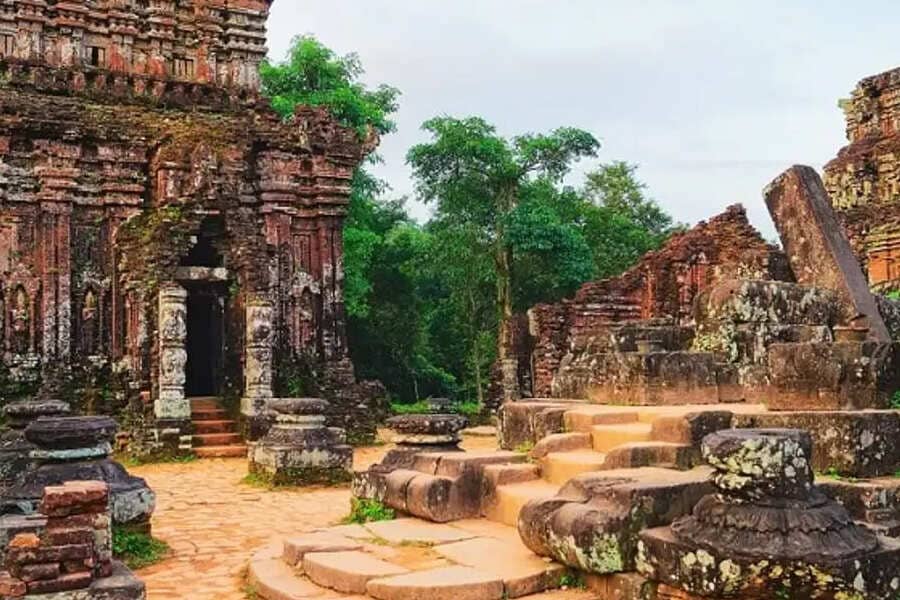
My Son Sanctuary was pivotal in Champa’s political, cultural, and religious life, evolving into a hub for art, commerce, and intellectual exchange over centuries. Despite challenges like natural decay and wartime damage, ongoing conservation efforts strive to preserve its architectural treasures and artifacts. Today, visitors can explore ancient temples, join guided tours to learn about the Champa civilization and experience firsthand the blend of spirituality and artistic expression at this UNESCO-recognized site.
The religious and historical significance of My Son Sanctuary
The My Son Sanctuary in Quang Nam Province, Vietnam, holds profound cultural and religious significance as a center for Hindu rituals dedicated primarily to the worship of the god Shiva. From the 4th to the 13th century CE, it served as a spiritual hub for the Cham civilization, where Cham priests conducted elaborate ceremonies and rituals honoring Shiva, a principal deity in Hinduism. These practices were integral to Cham’s spiritual life, reflecting their deep-seated beliefs and devotion.
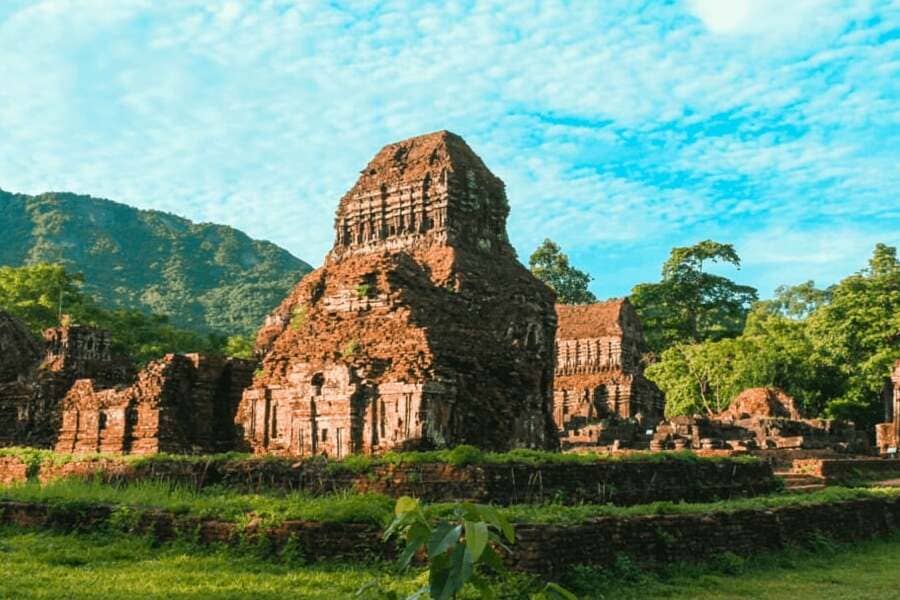
My Son Sanctuary exemplifies the peak of Cham’s architectural and artistic achievement. Constructed with distinctive fired brick, a hallmark of Cham Pa architecture, the temple structures blend indigenous Cham styles with influences from Indian Hindu temples. Adorned with intricate sculptures and bas-reliefs portraying Hindu deities and celestial beings, these carvings highlight Cham craftsmanship and offer insights into their religious beliefs. Designated as a UNESCO World Heritage Site in 1999, My Son continues to attract global visitors seeking to admire its architectural splendor and explore its rich cultural legacy rooted in Vietnam’s Champa civilization.
The magnificent architecture of My Son Sanctuary
Champa Architectural Style
The temples and towers of My Son Sanctuary, built from distinctive red brick, exemplify the architectural prowess of the Champa civilization. These structures, erected without mortar using a unique bonding technique, have stood the test of time, showcasing their durability and distinctive appearance. Adorned with intricate carvings depicting Hindu gods, goddesses, and mythological scenes, these temples highlight the artistic skills of the Champa people.
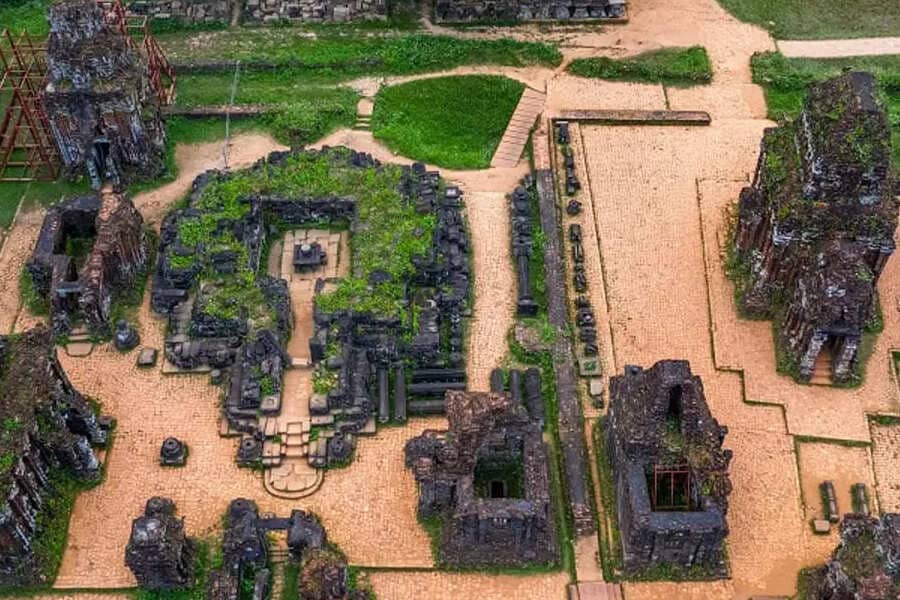
Influenced by Indian Hindu temple architecture, the towers feature tiered and tapered profiles resembling Mount Meru, a sacred mountain in Hindu and Buddhist cosmology. The Champa’s architectural style at My Son Sanctuary reflects their religious devotion and cultural sophistication, serving as a lasting testament to their historical legacy and interactions with Indian culture.
Sculptural Art at My Son Sanctuary
The sculptures at My Son Sanctuary include depictions of Hindu deities like Shiva and Ganesha, known for their symbolic attributes and distinctive features. Celestial beings like Apsaras represent beauty and grace, while guardian figures display muscular forms and intense expressions. Mythical creatures such as Naga and Garuda symbolize spiritual beliefs and enduring struggles.
Champa artisans employed stone carving in sandstone to create detailed designs with intricate jewelry and clothing patterns. They also mastered bronze casting using the lost-wax technique, crafting statues with durable, shiny finishes that reflect their artistic prowess and religious dedication, showcasing the cultural depth of the Champa civilization at My Son Sanctuary.
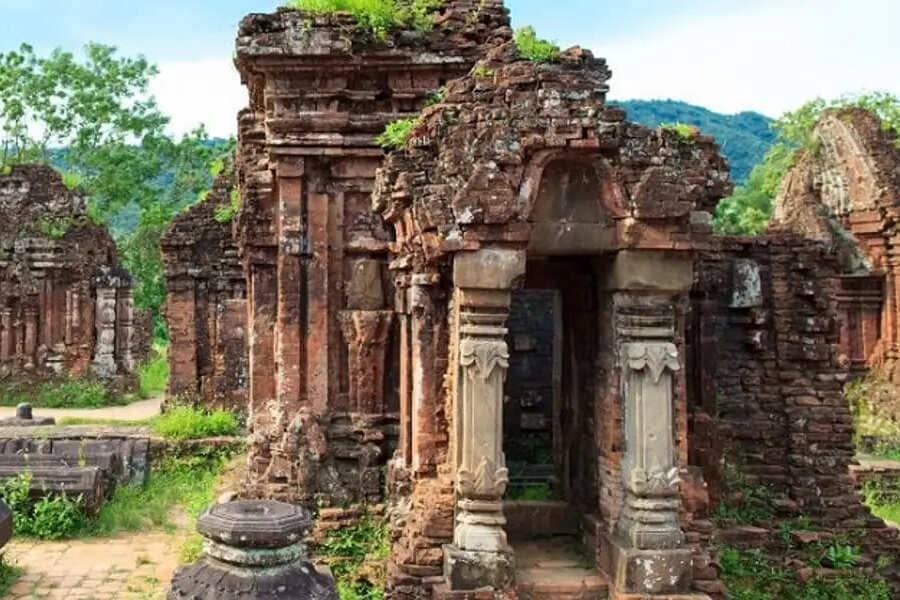
What makes My Son Sanctuary a magnet for tourists from all over?
My Son Sanctuary, nestled in Quang Nam province, Vietnam, holds UNESCO World Heritage status and beckons tourists globally with its distinctive allure. The architecture of My Son Sanctuary is a testament to its unique and sophisticated design, encompassing six distinct styles: ancient, Hoa Lai, My Son, Ponagar, Dong Duong, and the style of the Binh Dinh people.
Visitors are awestruck by the intricately carved stone statues depicting deities like Siva and female dancers in the distinctive Champa style. Despite enduring damage from US military bombing during the Vietnam War, My Son Sanctuary boasts several well-preserved towers with exceptional architecture that continue to captivate tourists.
Explore the panoramic vista of My Son Sanctuary
My Son Sanctuary houses over 70 elaborately carved temples adorned with significant inscriptions in Sanskrit and Cham. Discovered in 1898 by a French expedition, this hidden gem nestled amidst forested valleys, flanked by majestic mountains, offers a window into a forgotten era. The distinctive bricks used in constructing the ancient towers, meticulously fired and stacked without mortar, have stood the test of time, showcasing remarkable craftsmanship.
Experience the ancient road of unique breadth
An ancient road, unveiled during restoration efforts, leads to the heart of My Son Sanctuary. This 8m-wide path, flanked by intricately carved walls, historically guided kings, members of the royal family, and noble dignitaries to the revered center for worship. The discovery of this road has significantly enhanced the historical value of My Son Sanctuary, preserving its rich cultural heritage.
Enjoy the enchanting Apsara dance
A highlight of My Son Sanctuary is the Apsara dance, inspired by sandstone sculptures of celestial maidens. Known as the “Soul of Stone,” this graceful dance pays homage to the elegant curves of Champa women, performed against the backdrop of Paranung and Paranung drums and the haunting melodies of the Saranai flute. Tourists are transported to ancient Champa as they witness mesmerizing performances of Apsara dancers in their resplendent costumes.
Immerse yourself in the traditional Kate festival of the Cham people
The Kate Festival, a significant celebration in Cham culture, unfolds annually in July according to the Cham calendar. Visitors fortunate enough to coincide their visit with this festival experience a unique blend of heritage and tradition.
During the Kate Festival, rituals for peace, vibrant processions of ceremonial costumes and Kate (offering), and a captivating water procession are observed. Traditional music, graceful dances, and elaborate performances add to the festival’s allure, offering tourists an unforgettable cultural immersion.
My Son Sanctuary, with its rich history, breathtaking architecture, and vibrant cultural traditions, continues to enchant and inspire visitors from across the globe, ensuring its place as a cherished UNESCO World Heritage site.
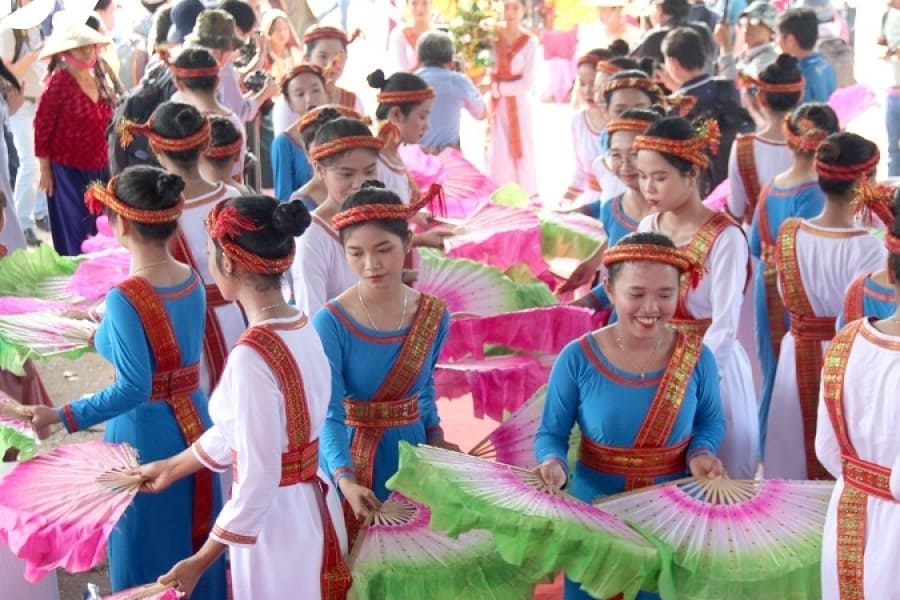
Cultural Events and Culinary Delights in My Son Sanctuary
At My Son Sanctuary, cultural events and culinary delights offer visitors a rich and immersive experience. You can witness mesmerizing Apsara dance performances, which are inspired by ancient stone sculptures of celestial maidens. These graceful dances, known as the “Soul of Stone,” unfold against the backdrop of traditional music and the sound of Paranung and Saranai flute.
During the Katê festival in July, immerse yourself in Cham rituals and traditions. Witness colorful processions featuring ceremonial costumes and offerings, and experience captivating cultural performances that showcase the Cham people’s vibrant heritage.
To complete your sensory journey, indulge in local delicacies such as Grilled beef served with various herbs and dipping sauce, Mì Phú Chiêm (a type of crispy noodles), Bánh Đập (rice crackers), Bánh Bèo (steamed rice cakes), and Bánh Tổ (grilled rice cakes). These dishes offer a taste of authentic Cham cuisine, enhancing your exploration of My Son Sanctuary’s cultural and culinary treasures.
How to get to My Son Sanctuary?
To reach My Son Sanctuary, you have a few options depending on where you start your journey. Make a plan to ensure a smooth journey to this UNESCO World Heritage site, known for its ancient Cham temples and rich cultural history.
My Son Sanctuary is about 40 kilometers southwest of Hoi An. The most convenient way to get there from Hoi An is by booking a tour or hiring a taxi. Tours typically include transportation and a guide, providing a hassle-free experience. Taxis can also be hired for a direct ride to My Son Sanctuary. Vietnam shore excursions offer various options for visiting My Son Sanctuary, ensuring a comfortable and informative trip.
My Son Sanctuary is approximately 70 kilometers from Da Nang. Similar to Hoi An, you can take a guided tour or hire a taxi from Da Nang. Tours often include other attractions in the area, making it a comprehensive experience.
There are also public buses that run between Hoi An and My Son Sanctuary. You can catch a bus from Hoi An to the town of Duy Phu and then take a taxi or motorbike to My Son Sanctuary.
Renting a motorbike in Hoi An or Da Nang offers flexibility for those comfortable riding. The route to My Son Sanctuary is scenic, passing through rural landscapes, although roads can be narrow and winding in some areas.
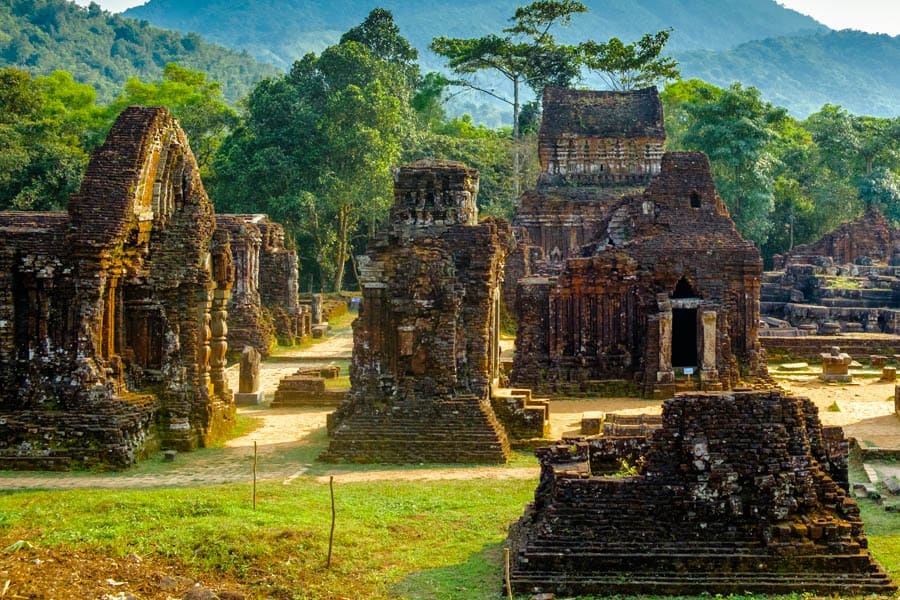
Best Times to Visit My Son Sanctuary
The ideal months to visit are February to April. This period falls during the dry season, ensuring pleasant weather and minimizing the chance of heavy rains. It’s perfect for exploring the sanctuary comfortably. Visiting during these months allows you to enjoy the ancient temples and cultural heritage of My Son Sanctuary without weather-related disruptions, making your experience memorable and enjoyable.
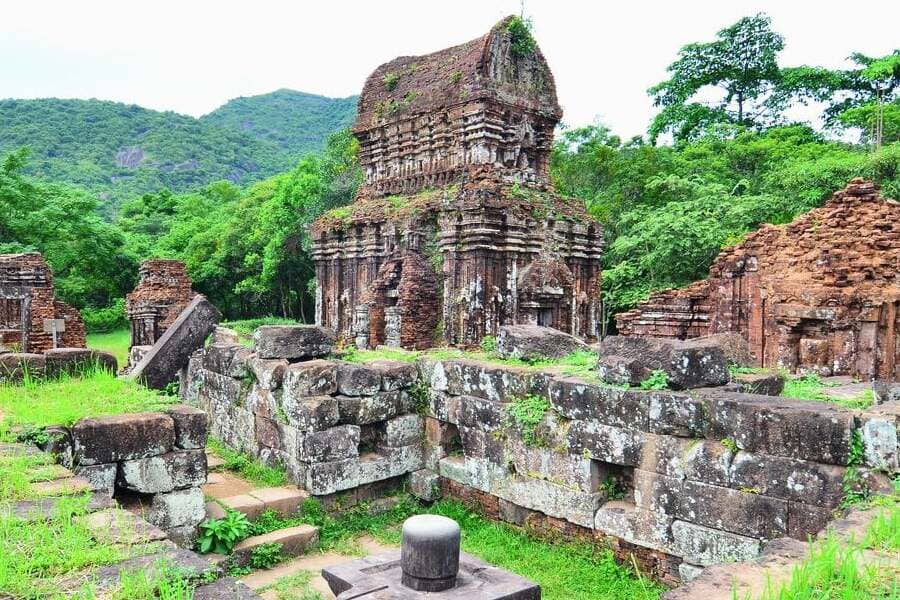
Where should stay when visiting My Son Sanctuary?
Due to its heritage status, My Son Sanctuary typically operates from 6:00 a.m. to 5:00 p.m. This means travelers often choose to visit during daytime hours when planning their Danang shore excursions. To make the most of your visit, consider exploring the “The Central Heritage Road of Central Vietnam”, which connects various significant cultural sites in the region.
For accommodation, opt for a quality hotel that offers convenient access to both My Son Sanctuary and other popular tourist destinations nearby. Choosing a hotel with a suitable distance ensures you can easily travel to and from these sites, maximizing your time for exploration and relaxation.
By selecting accommodation strategically and planning your visit during operational hours, you can enjoy a seamless and fulfilling experience exploring the rich cultural heritage of My Son Sanctuary and its surroundings.

